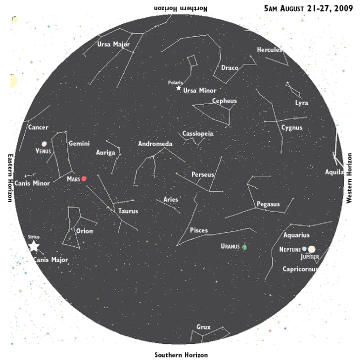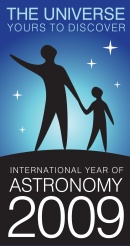
Volume XVII, Issue 34 # August 20 - August 26, 2009 |
 |
 |
Sky Watch
by J. Alex Knoll
The Dog Days of Summer
Now that’s some hot stuff
Our summer may be waning, but these late-August days are still scorchers. If you’re up letting the dog out before dawn one morning, you will see the one-time presumed culprit for all this heat, Sirius the dog star.
 The lead star in the constellation Canis Major, or the big dog, Sirius is the brightest star in the heavens. Sirius comes from the Greek word Seirios, meaning searing or scorching, and at magnitude –1.5 it does just that, shining twice as bright as any other star. The ancient Greeks believed that the hottest days of summer were a result of the additional heat from Sirius, which at the time rose at dawn in conjunction with the sun at summer’s peak, and so they called these the dog days of summer.
The lead star in the constellation Canis Major, or the big dog, Sirius is the brightest star in the heavens. Sirius comes from the Greek word Seirios, meaning searing or scorching, and at magnitude –1.5 it does just that, shining twice as bright as any other star. The ancient Greeks believed that the hottest days of summer were a result of the additional heat from Sirius, which at the time rose at dawn in conjunction with the sun at summer’s peak, and so they called these the dog days of summer.
In some ways the Greeks weren’t far off, as we now know that Sirius is quite close: at 8.5 light-years away, it is our fifth-closest stellar neighbor. And while the dog star is roughly double the size of our sun, it burns hot, shining 20-some times more luminous than the sun.
While we still consider these the dog days, Sirius no longer rises with the dawn, but appears in the southeast around 5am — a full 90 minutes before sunrise. This shift is a result of something called the precession of the equinoxes, in which the backdrop of the heavens shifts over a period of 26,000 years.
Imagine the earth as a spinning top, tilted at 231⁄2 degrees and wobbling slightly from side to side as the sun’s gravity tugs at it. The handle of the top traces an elliptical circle, pointing toward a different location in space as it turns, much as our view of the heavens changes over millennia.
Illustration: © Copyright 1925 M.C. Escher/Cordon Art-Baarn-Holland; Graphics: © Copyright 2009 Pacific Publishers. Reprinted by permission from the Tidelog graphic almanac. Bound copies of the annual Tidelog for Chesapeake Bay are $14.95 ppd. from Pacific Publishers, Box 480, Bolinas, CA 94924. Phone 415-868-2909. Weather affects tides. This information is believed to be reliable but no guarantee of accuracy is made by Bay Weekly or Pacific Publishers. The actual layout of Tidelog differs from that used in Bay Weekly. Tidelog graphics are repositioned to reflect Bay Weekly’s distribution cycle.Tides are based on National Oceanic and Atmospheric Administration and are positioned to coincide with high and low tides of Tidelog.
